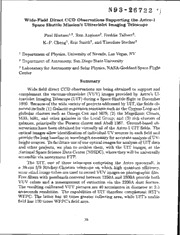
NASA Technical Reports Server (NTRS) 19930017533: Wide-field direct CCD observations supporting the Astro-1 Space Shuttle mission's Ultraviolet Imaging Telescope PDF
Preview NASA Technical Reports Server (NTRS) 19930017533: Wide-field direct CCD observations supporting the Astro-1 Space Shuttle mission's Ultraviolet Imaging Telescope
! N 9 3 - 2 6 7 22 i l Wide-Field Direct CCD Observations Supporting the Astro-1 Space Shuttle Mission's Ultraviolet Imaging Telescope Paul Hintzen1'3, Ron Angione2. Freddie Talbert.2, K.-P. Cheng3, Eric Smith3, and Theodore Stecher3 1 Department of Physics, University of Nevada, Las Vegas, NV 2 Department of Astronomy, San Diego State University 3 Laboratory for Astronomy and Solar Physics, NASA-Goddard Space Flight Center Summary Wide field direct CCD observations are being obtained to support and complement the vacuum-ultraviolet (VUV) images provided by Astro's Ul- traviolet Imaging Telescope (UIT) during a Space Shuttle flight in December 1990. Because of the wide variety of projects addressed by UIT, the fields ob- served include (1) Galactic supernova remnants such as the Cygnus Loop and globular clusters such as Omega Cen and M79; (2) the Magellanic Clouds, M33, M81, and other galaxies in the Local Group; and (3) rich clusters of galaxies, principally the Perseus cluster and Abell 1367. Ground-based ob- servations have been obtained for virtually all of the Astro-1 UIT fields. The optical images allow identification of individual UV sources in each field and provide the long baseline in wavelength necessary for accurate analysis of UV- bright sources. To facilitate use of our optical images for analysis of UIT data and other projects, we plan to archive them, with the UIT images, at the National Space Science Data Center (NSSDC), where they will be universally accessible via anonymous FTP. The UIT, one of three telescopes comprising the Astro spacecraft, is a. 38-tcm f/9 Ritchey-Chretien telescope on which high quantum efficiency, solar -oiind image tubes are used to record VUV images on photographic film. Five filters with passbands centered between 1250A and 2500A provide both VUV colors and a measurement of extinction via the 2200A dust feature. The resulting calibrated VUV pictures are 40 arcminutes in diameter at 2.5 arcseconds resolution. The capabilities of UIT therefore complement HST's WFPC: The latter has 40 times greater collecting area, while UIT's usable field has 170 times WFPC's field area. 38 During the Astro mission, UIT obtained data for a wide variety of sci- entific projects. Low redshift galaxies were major targets for UIT, as study of their OB associations should yield fundamental information on the initial mass function for massive star formation, the resulting supernova rates, and ionizing radiation fields. At larger distances, UIT surface brightness obser- vations are similarly being used to study the initial mass functions for star formation in a sample of nearby galaxies, since integrated VUV colors and color profiles provide the most sensitive available measure of the formation rate of massive stars. The blue stages later in stellar evolution are also being studied, e.g. UIT observations at 1500A detected 1300 hot horizontal branch stars (HHB) in Omega Cen. Such a large statistical sample is necessary to place constraints on mass loss during the red giant phase, which is probably the dominant, factor determining the future evolution of these stars as well as a central issue in the chemical enrichment of the interstellar medium. These data will also allow more accurate determination of the helium abundances and metallicities of HHB stars. In all of these projects, supporting ground-based data are critical. De- pending on the type of object, optical images have been obtained in some combination of filters which may include U, B, V, R and/or narrow-band H- alpha and [OIII] 5007A. A mere three years ago, only photographic plates would have allowed coverage of the 40 arcminute diameter UIT fields. How- ever, the fortuitous development, of a new generation of large-format CCDs has allowed us to acquire optical observations with seeing-limited resolution and linear flux response while still covering a substantial fraction of each UIT frame with one to four integrations. Objects accessible from the Northern Hemisphere were observed from Kitt Peak National Observatory or SDSU's Laguna Observatory; their complementary observing seasons allow year-round coverage. Objects accessible only from the Southern Hemisphere, including the Magellanic Clouds and 47 Tucanae, were observed from Cerro Tololo In- teramerica Observatory. Data from the National Observatories were taken with Tek 2048 CCDs on 0.9-meter telescopes, yielding seeing-limited resolu- tion over fields of 20+ arcminutes (KPNO) and 14 arcminutes (CTIO). At Laguna Observatory, a focal reducer was used in conjunction with a TI SOO CCD, providing fields of 11 to 18 arcminutes depending on the field lens used. All data were reduced using standard IRAF routines. The reduced, photo- metrically calibrated data, in FITS format, will be distributed by the NSSDC to interested investigators upon request. 39
